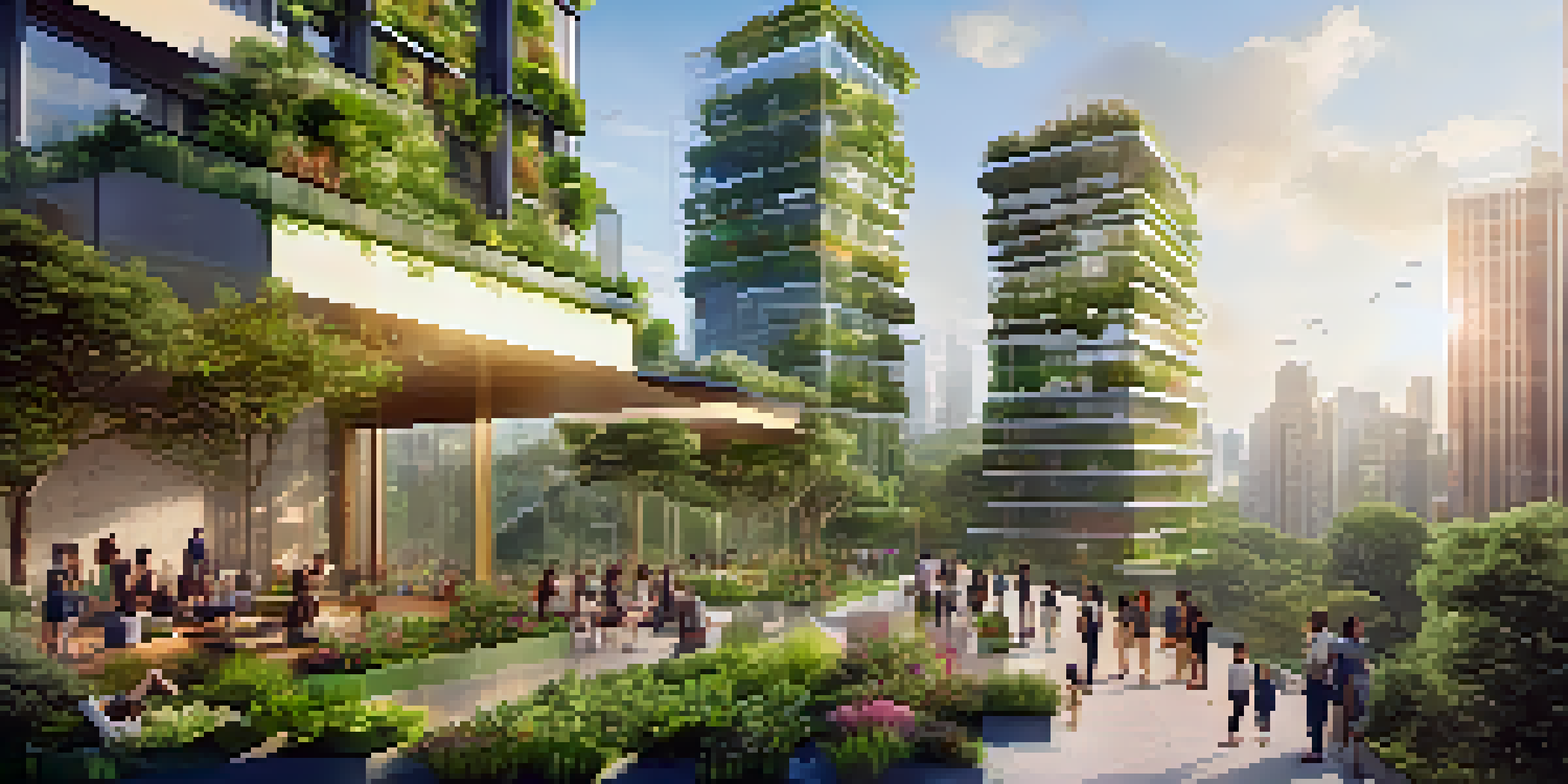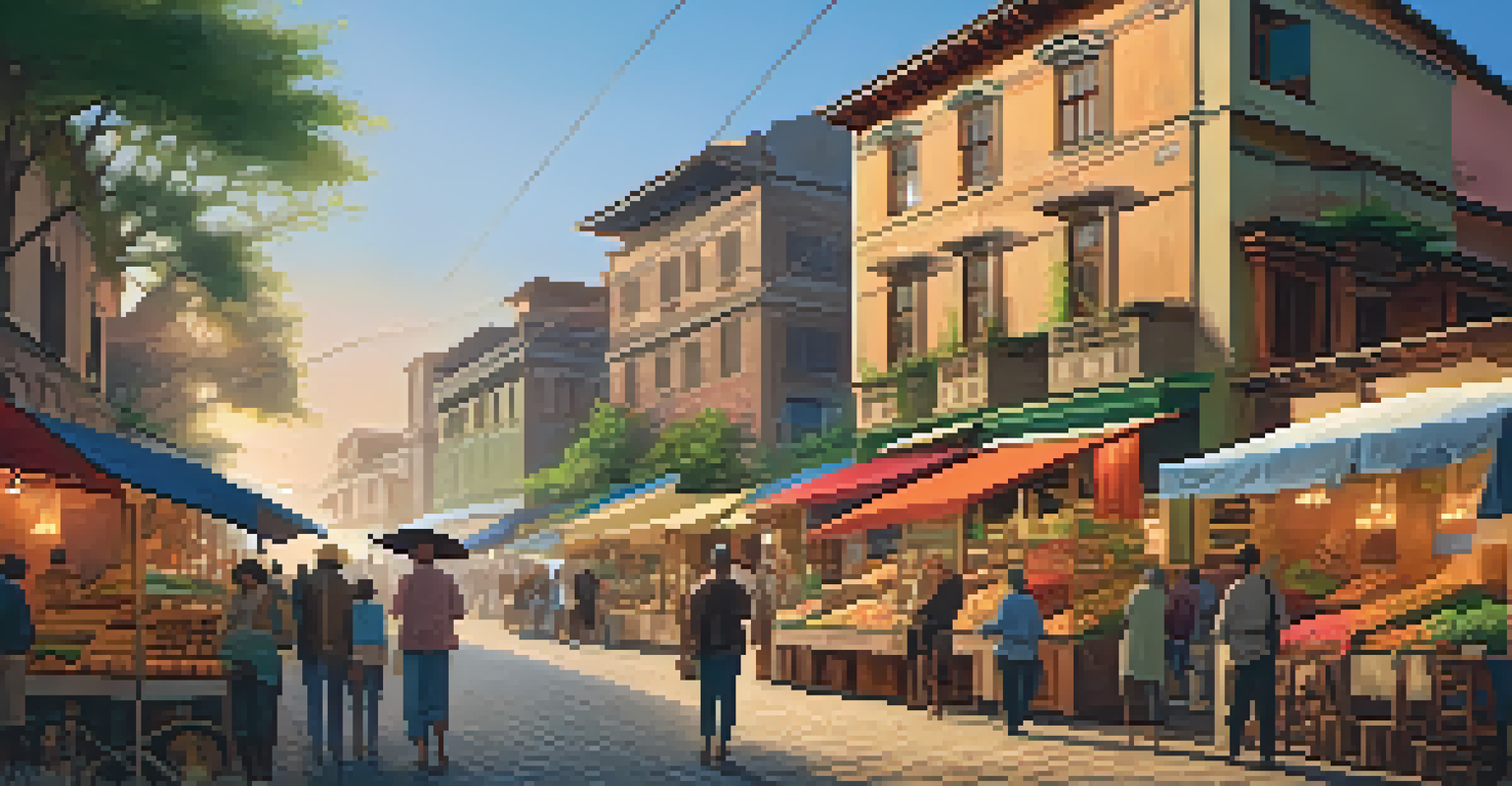Innovative Designs in Modern Urban Architecture

The Rise of Sustainable Architecture in Cities
Sustainable architecture is more than just a trend; it's a necessity in modern urban design. As cities around the world grapple with climate change, architects are increasingly focusing on eco-friendly materials, energy-efficient systems, and designs that harmonize with nature. Think of buildings that not only reduce their carbon footprint but also contribute positively to their environment, like vertical gardens and green roofs.
Architecture should speak of its time and place, but yearn for timelessness.
For instance, the Bosco Verticale in Milan showcases how residential towers can incorporate lush greenery, providing fresh air and biodiversity in densely populated areas. These innovations not only enhance the aesthetic appeal but also improve residents' well-being by bringing nature closer to urban living. This shift towards sustainability reflects a collective understanding that our cities need to be healthier places for people and the planet.
Moreover, sustainable architecture often leads to long-term cost savings through energy efficiency and reduced resource consumption. As more architects embrace this philosophy, we can expect to see a future where urban environments thrive in balance with nature, showcasing the beauty of both innovative design and ecological responsibility.
Adaptive Reuse: Breathing New Life into Old Structures
Adaptive reuse is a fascinating concept in urban architecture that involves repurposing old buildings for new functions. This practice not only preserves the historical value of structures but also reduces waste and the need for new materials. Imagine turning an abandoned warehouse into a trendy loft or a former factory into a vibrant community center—it's like giving a new lease on life to forgotten spaces.

Cities like Detroit and Brooklyn have successfully implemented adaptive reuse projects, transforming derelict sites into hubs of creativity and culture. These revitalized spaces often become focal points for community engagement, offering a blend of history and modernity. The stories embedded in these buildings add character and a sense of identity, making them cherished landmarks.
Sustainable Architecture is Essential
Modern urban design increasingly focuses on eco-friendly materials and energy-efficient systems to combat climate change.
Additionally, adaptive reuse can be a more sustainable approach to urban development, as it minimizes the environmental impact associated with demolishing old structures. By embracing this strategy, urban planners can foster growth while honoring the past, creating an inspiring balance that resonates with both residents and visitors alike.
Smart Technology: The Future of Urban Living
Smart technology is revolutionizing urban architecture, making cities more efficient and livable. From smart lighting systems that adjust based on occupancy to buildings equipped with energy management software, technology is enhancing the functionality of urban spaces. Imagine living in a smart home that anticipates your needs, optimizing energy use while offering convenience at your fingertips.
The best way to predict the future is to invent it.
Incorporating the Internet of Things (IoT) into design allows for real-time data collection, enabling building managers to monitor energy consumption, security, and even air quality. This level of connectivity not only improves operational efficiency but also significantly enhances the comfort of residents. Cities like Singapore are already leading the way in integrating smart technology into their urban planning, showcasing how innovative design can benefit communities.
Furthermore, smart designs promote sustainable living by encouraging efficient resource use and reducing waste. As technology continues to evolve, we can expect an even more integrated approach to urban architecture, where buildings, infrastructure, and residents work in harmony to create smarter, more responsive environments.
Biophilic Design: Connecting People with Nature
Biophilic design is a concept that emphasizes the connection between humans and nature within built environments. This design philosophy seeks to incorporate natural elements into architecture, such as light, water, and greenery, fostering a sense of well-being and tranquility. Imagine walking into a building where sunlight floods the space, plants hang from walls, and water features create a soothing ambiance—this is the essence of biophilic design.
Research has shown that exposure to nature can improve mental health, productivity, and overall happiness. By integrating these elements into urban architecture, designers are not only enhancing aesthetics but also nurturing residents' physical and emotional well-being. An excellent example of this is the Eden Project in the UK, which combines stunning architecture with lush plant life to create an immersive natural experience.
Adaptive Reuse Preserves History
Transforming old buildings for new purposes not only reduces waste but also enriches community identity and culture.
As urban spaces become increasingly crowded, biophilic design offers a refreshing antidote to the concrete jungle. By prioritizing nature in our everyday environments, we can create cities that nourish our souls while promoting sustainability and connection to the world around us.
Modular Construction: Flexibility in Urban Design
Modular construction is an innovative approach that involves pre-fabricating building components off-site and then assembling them on location. This method not only speeds up the construction process but also allows for greater flexibility in design. Imagine a city where homes and offices can be easily adapted or expanded to meet changing needs—this is the promise of modular architecture.
One of the significant advantages of modular construction is its potential for cost savings. By streamlining the building process and reducing waste, developers can offer affordable housing solutions in urban areas. Cities like Amsterdam are already embracing modular design, creating vibrant communities that are both functional and visually appealing.
Additionally, modular buildings can often be disassembled and relocated, making them a sustainable option for urban development. As the demand for adaptable spaces grows, modular construction will likely play a crucial role in shaping the future of our cities, offering a versatile solution to meet the evolving needs of urban populations.
Minimalism: The Art of Simplified Urban Spaces
Minimalism in architecture champions simplicity, functionality, and the idea that less is more. This design philosophy strips away unnecessary embellishments, focusing instead on clean lines and open spaces. Picture a serene urban dwelling with large windows, neutral colors, and a clutter-free environment—this is the essence of minimalist design.
The appeal of minimalism lies not only in its aesthetic but also in its practicality. In densely populated cities, creating spaces that feel open and airy can significantly enhance the quality of life for residents. By maximizing natural light and reducing visual clutter, minimalist architecture promotes mindfulness and tranquility amidst the hustle and bustle of urban life.
Smart Tech Enhances Urban Living
Integrating smart technology into urban architecture improves efficiency, comfort, and promotes sustainable living.
Cities like Tokyo exemplify minimalist design, showcasing how small spaces can be transformed into functional and stylish homes. As urban living continues to evolve, the principles of minimalism will likely remain influential, encouraging designers to create environments that prioritize simplicity and serenity.
Cultural Influences: Celebrating Diversity in Architecture
Cultural influences play a vital role in shaping urban architecture, reflecting the diverse identities of communities. Each region has its unique architectural language, often rooted in history, tradition, and local materials. Consider the vibrant colors and intricate patterns of Moroccan architecture, which tell stories of cultural heritage and craftsmanship in every detail.
In contemporary urban design, architects are increasingly drawing inspiration from local cultures to create spaces that resonate with residents. This approach fosters a sense of belonging and pride, as buildings become symbols of community identity. Cities like Barcelona showcase how cultural influences can lead to stunning architectural masterpieces, blending modernity with tradition.

By celebrating diversity in architecture, we not only honor the past but also pave the way for inclusive urban environments. As cities become melting pots of cultures, the architectural landscape will continue to evolve, reflecting the rich tapestry of human experience and creativity.